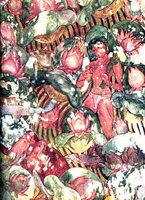
Sittannavasal ('sith-than-na-vaa-sal') is the best-known archaeological site in Pudukkottai, TamilNadu. It is famous for its cave paintings, which are second only in importance after Ajanta paintings in the art history of India. It is perhaps the only place where you can find inscriptions in Tamil from the 3rd century BC to the 13th century AD. Also there are megalithic monuments such as stone-circles, urn and cists burials spread in the plains around the hill
One of the steep hills in the village contains an isolated but spacious cavern. Locally, this cavern is known as Ezhadippattam, a name that is derived from the seven holes cut into the rock that serve as steps leading to the shelter. Within the cave there are seventeen stone berths aligned into rows, and each of these has a raised portion that could have served as a pillow-loft. The largest stone berth has a distinct Bramhi inscription assignable to the second B.C.E., and some inscriptions belonging to eighth C.E. are also found on the nearby beds.

The Sittannavasal cavern continued to be the "Holy Samana Abode" until the seventh and eighth centuries. Inscriptions over the remaining stone berths name mendicants such as Tolakunrattu Kadavulan, Tirunillan, Tiruppuranan, Tittaicbaranan, Sri Purrnacandl"an, and Nityakaran Pattakali as monks, who no doubt, were resolved to spend their lives in isolation at Sittannavasal.
The neighboring hill, not far from these natural caverns, possesses a rock-cut temple The basement mouldings of the shrine are rather simple and its architectural style belongs to seventh century.

The shrine has a row of three Tirthankaras carved on the rear wall. These icons are almost identical in seated padmasana posture and crowned by triple umbrellas. They are said to be Adinatha, Neminatha and Mahavira, even though their identifying symbols are conspicuously absent. The lateral walls of the mandapa contain two niches accommodating bold relief's of Parsvanath and another unidentified icon, probably of a preceptor. The image of Parsvanatha is majestically shown seated in the dhyana posture and is canopied by a five-hooded serpent. The calm countenance in contrast to the sturdy nature of the torso exhibits the superior skill of the Pandya sculptor.
Pudukottai.org gives details on the Jain Cave Temple, the Sittannavasal Paintings, Ezhadippattam, and The Navach-chunai,
The Hindu also covers sittannavasal in their Rocky Retreat.
No comments:
Post a Comment